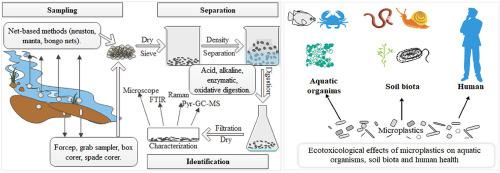Ecotoxicology and Environmental Safety ( IF 6.2 ) Pub Date : 2020-06-30 , DOI: 10.1016/j.ecoenv.2020.110910 Mengjie Wu 1 , Chunping Yang 2 , Cheng Du 3 , Hongyu Liu 4

|
Microplastics (MPs) are ubiquitous in the environment and more abundant in the marine environment. Consequently, increasing focus has been put on MPs in oceans and seas, while little importance has been attached to their presence in freshwaters and soils. Therefore, this paper aimed to provide a comprehensive review of the occurrence, analysis and ecotoxicology of MPs. The abundance and distribution of MPs in several typical freshwater systems of China were summarized. It suggested that the surface water of Poyang Lake contained the highest concentration of 34 items/L MPs among all the 8 freshwater systems, and the content of MPs in sediments were higher than that of the surface water. Net-based zooplankton sampling methods are the most frequently utilized sampling methods for MPs, and density separation, elutriation and digestion are three major pretreatment methods. Fourier transform infrared spectroscopy, Raman spectroscopy and pyrolysis-gas chromatography coupled to mass spectrometry are often used to identify the polymer types of MPs. Besides, MPs might damage the digestive tract of various organisms and negatively inhibit their growth, feeding and reproduction. The ways of human exposure to MPs are by ingestion, inhalation and dermal exposure, digestive and respiratory system might be adversely influenced. However, potential health risks of MPs to humans are remained insufficiently researched. Overall, by showing the presence of MPs in freshwaters and soils as well as possible ecotoxicological effects on the environment and humans, this paper provided a framework for future research in this field.
中文翻译:

水和土壤中的微塑料:发生、分析方法和生态毒理学效应。
微塑料 (MP) 在环境中无处不在,在海洋环境中更为丰富。因此,人们越来越关注海洋中的 MP,而很少有人重视它们在淡水和土壤中的存在。因此,本文旨在对 MPs 的发生、分析和生态毒理学进行全面综述。总结了我国几种典型淡水系统中MPs的丰度和分布。说明鄱阳湖表层水MPs含量在8个淡水水系中最高,达34项/L,沉积物中MPs含量高于表层水。基于网络的浮游动物采样方法是 MP 最常用的采样方法,密度分离,淘析和消化是三种主要的预处理方法。傅里叶变换红外光谱、拉曼光谱和热解气相色谱与质谱联用通常用于鉴定 MP 的聚合物类型。此外,MPs可能会损害各种生物的消化道,对它们的生长、摄食和繁殖产生负面影响。人体接触 MPs 的途径有食入、吸入和皮肤接触,消化和呼吸系统可能受到不利影响。然而,MPs 对人类的潜在健康风险仍未得到充分研究。总的来说,通过展示 MPs 在淡水和土壤中的存在以及对环境和人类可能产生的生态毒理学影响,本文为该领域的未来研究提供了一个框架。傅里叶变换红外光谱、拉曼光谱和热解气相色谱与质谱联用通常用于鉴定 MP 的聚合物类型。此外,MPs可能会损害各种生物的消化道,对它们的生长、摄食和繁殖产生负面影响。人体接触 MPs 的途径有食入、吸入和皮肤接触,消化和呼吸系统可能受到不利影响。然而,MPs 对人类的潜在健康风险仍未得到充分研究。总的来说,通过展示 MPs 在淡水和土壤中的存在以及对环境和人类可能产生的生态毒理学影响,本文为该领域的未来研究提供了一个框架。傅里叶变换红外光谱、拉曼光谱和热解气相色谱与质谱联用通常用于鉴定 MP 的聚合物类型。此外,MPs可能会损害各种生物的消化道,对它们的生长、摄食和繁殖产生负面影响。人体接触 MPs 的途径有食入、吸入和皮肤接触,消化和呼吸系统可能受到不利影响。然而,MPs 对人类的潜在健康风险仍未得到充分研究。总的来说,通过展示 MPs 在淡水和土壤中的存在以及对环境和人类可能产生的生态毒理学影响,本文为该领域的未来研究提供了一个框架。拉曼光谱和热解气相色谱与质谱联用通常用于鉴定 MP 的聚合物类型。此外,MPs可能会损害各种生物的消化道,对它们的生长、摄食和繁殖产生负面影响。人体接触 MPs 的途径有食入、吸入和皮肤接触,消化和呼吸系统可能受到不利影响。然而,MPs 对人类的潜在健康风险仍未得到充分研究。总的来说,通过展示 MPs 在淡水和土壤中的存在以及对环境和人类可能产生的生态毒理学影响,本文为该领域的未来研究提供了一个框架。拉曼光谱和热解气相色谱与质谱联用通常用于鉴定 MP 的聚合物类型。此外,MPs可能会损害各种生物的消化道,对它们的生长、摄食和繁殖产生负面影响。人体接触 MPs 的途径有食入、吸入和皮肤接触,消化和呼吸系统可能受到不利影响。然而,MPs 对人类的潜在健康风险仍未得到充分研究。总的来说,通过展示 MPs 在淡水和土壤中的存在以及对环境和人类可能产生的生态毒理学影响,本文为该领域的未来研究提供了一个框架。摄食和繁殖。人体接触 MPs 的途径有食入、吸入和皮肤接触,消化和呼吸系统可能受到不利影响。然而,MPs 对人类的潜在健康风险仍未得到充分研究。总的来说,通过展示 MPs 在淡水和土壤中的存在以及对环境和人类可能产生的生态毒理学影响,本文为该领域的未来研究提供了一个框架。摄食和繁殖。人体接触 MPs 的途径有食入、吸入和皮肤接触,消化和呼吸系统可能受到不利影响。然而,MPs 对人类的潜在健康风险仍未得到充分研究。总的来说,通过展示 MPs 在淡水和土壤中的存在以及对环境和人类可能产生的生态毒理学影响,本文为该领域的未来研究提供了一个框架。











































 京公网安备 11010802027423号
京公网安备 11010802027423号